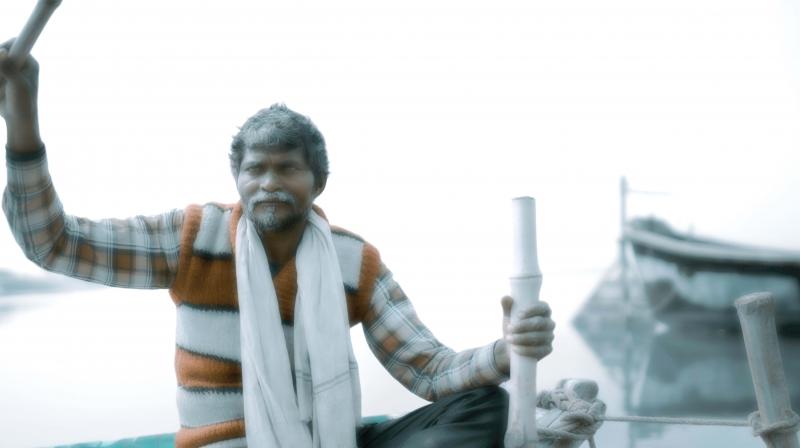When the Mallaahs come rowing in
A new show on one of the most colourful events in the country, the Kumbh Mela, showcases an unlikely subject by the ‘abstractionist’

A pictorial series on Kumbh Mela at Prayagraj is invariably about dreadlock naga sadhus and the ocean of humanity flocking there to bathe at Triveni Sangam, the confluence of rivers. Which is the reason why photographer Shibu Arakkal almost said no to a commissioned project on Kumbh Mela by Sandeep & Gitanjali Foundation in association with Gallery G. “It is one of the most widely covered events,” he said. “Every photographer has done something on it. What else could I add to this?”
But he did go to the Kumbh Mela for a week on the assurance that he will exercise his artistic freedom to choose what to do. As Gitanjali Maini said, “I had been keenly observing his work since 2014 and realised that here was a photo artist who looked at things differently and saw a new story in everything around him. We were not looking for him to capture images of akharas and naga sadhus.” Scouting the place along with local guides, he was drawn to a community which has been integral to the Kumbh Mela and has been worshipping the sacred rivers, Ganga and Yamuna, for “hundreds of years”. His subject, for the solo show Mallaah, is on this community of boatmen who are overlooked by the shutterbugs who are taken in by the frenzy of activities going on at the Kumbh. Calling them as the caretakers of the river, Shibu decided to take their portraits as a way to symbolise their cultural contribution to such a significant event.
“The Mallaah (or Nishad) are the traditional boatmen, caste and ethnic group of North India, East India and Pakistan, a small number of them also found in Nepal, Shibu said. “The term, ‘Mallaah’ is said to have originated from an Arabic word signifying a motion of moving like a bird’s wings.” The routine for the days at the Kumbh fell in place as Shibu took the pictures either early mornings when the boatmen were setting out for the day or else in twilight when they returned.
“They are busy during the day and didn’t want to be disturbed,” he said. During the period he was there, Shibu learned more about the patriarchal set-up of the Mallaah community, where although the families live on the banks of the rivers, only the men go out to work. “They are often in their boats for long durations and they sleep, clean and cook there,” he said, pointing out to the portrait of one boatman whose face is awash with warm orange light coming from the embers of the ‘chullah’. However, of the twelve portraits on display, Shibu talks of a “pivotal” portrait of a father and son. Making small conversation, he asked the son of future plans and continuing the tradition. “The boy told me that he wants to become a policeman.” The photographer now feels that his series may just be a documentation of a dying tradition hence validating his choice of subject. Artist cum curator Riyas Komu, affirmed this conviction in a curatorial note, “From a purely cultural point of view, that is the world of public opinion, ideas, and ideologies, these images may become a part of the archive of the forgotten world.”
Talking about the technique and styling, those following Shibu’s works over the past twenty years will know that he has a tendency to devote a lot of time on post production. These images, according to him, has over 100 hours of work on each of them. This is to do with his inspiration, the early 20th century pictorialism, a style that concentrated on manipulating a straightforward image into something else. While Shibu’s previous works have been stark, these images are “soft and romantic” with fuzzy focus. This is an intentional effect and so one need not adjust their focal point. “Someone told me that I had freed the boatmen years of their existence which is precisely what I wanted to do,” he commented. “I wanted to take away the harshness.”
This show is Shibu’s third solo on figurative works. The other series, about 10-14, are abstracts. He calls himself an abstractionist. This series, in look and feel, has similarities to his Bhutan (landscape) series but he calls the technique employed here as new and arduous. The portraiture, unlike the style, is direct with every subject making eye contact. There is a warmth in the gaze, even when some are enveloped in a hazy layer, which perhaps, speaks volumes of the photographer’s engagement with the subject. The Mallah is captured along with his entire life; his boat and the river. These portraits, therefore, encapsulates a world within the frenetic world of Kumbh Mela which isn’t in the frame at all. And just as one’s feelings inside may be entirely different from what’s seen on the outside, “like night and day” is exactly how different Shibu’s initial and final images are.
What: Mallah
When: Aug. 12 to Sept. 9, 10am - 7pm
Where: Gallery G

